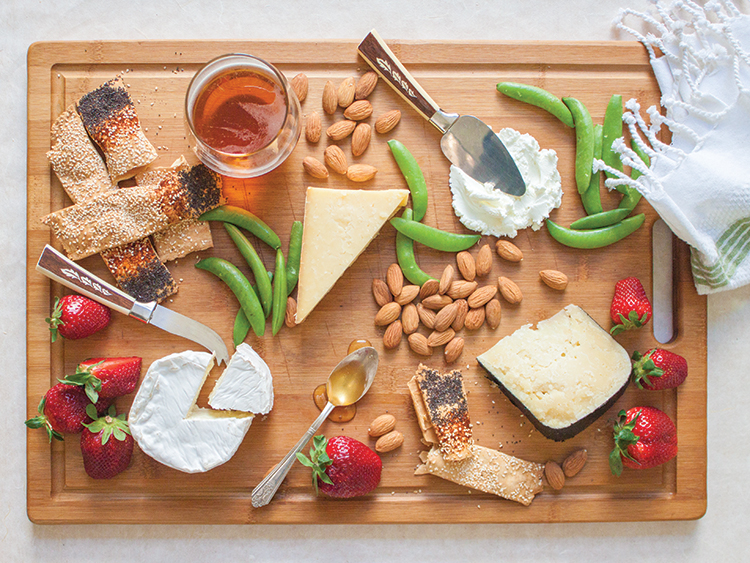Photo by Marika Mirren
Simple Pleasures
by Alex Jones
No food tantalizes eaters quite like cheese. I’ve been sourcing and selling artisan cheeses produced on small-scale farms and dairies in Pennsylvania and New Jersey for seven years, and it still makes me smile whenever a farmers market shopper slows down as they approach my table and whispers, “Oooh, cheese.”
What many cheese lovers don’t realize is that their favorite food doesn’t have to be a guilty pleasure. Consuming small-batch, handcrafted cheeses made with high-quality, grass-fed milk using traditional techniques is the most nutritious way to enjoy that dairy deliciousness. And with flavorful, nutrient-dense, full-fat dairy products, you can eat a little less per serving to feel full and get the best value out of your local food dollars.
While there’s nothing wrong with keeping it simple with a delicious wedge of scrumptious local cheese and a box of your favorite crackers, I feel good about taking the time to select a few cheeses to serve together, along with seasonal accompaniments and—if I’m getting fancy—a beverage pairing to round out the plate.
Spend a little time choosing well and your cheesy investment can go from a quick snack to a nourishing, no-cook meal that feels special, tastes delicious and only takes a few minutes to put together.
How you choose your local cheeses will depend on your source: If you frequent a farmers market with only one cheesemaker stand, you may tend to purchase your wedges all from the same maker. In this case, it’s a good rule of thumb to select a variety of ages and textures of cheese, depending on what they offer—a fresh, spreadable cheese, a stinky washed rind and a hard Alpine-style make a nice combination. A lush, Brie-style bloomy rind (so named for the white mold that “blooms” across the surface during aging) and a pungent, crumbly blue can offset each other nicely. The friendly monger behind the table can give you suggestions.
If you’re buying cheese from a retail counter, Talula’s Daily in Washington Square West can be counted on to stock several local varieties amid other domestic artisan cheeses and European classics in their small but mighty case. Di Bruno Bros. usually has a few local types on hand too, but availability and selection vary depending on the location.
For the widest variety of local cheese, look no further than the Fair Food Farmstand, nestled between Pennsylvania Dutch ribs and Carmen’s cheesesteaks on the 12th Street side of Reading Terminal Market. They exclusively sell cheeses from makers in Pennsylvania and New Jersey and stock local takes on everything from Brie to cheddar to Gruyere.
Here, variety is still a good guideline—choose a soft, a medium and a hard cheese; fresh, bloomy and blue; raw and pasteurized. You can also focus on one style and try multiple types of that variety on the same plate. Compare Brie styles, Alpine styles, ash-rubbed cheeses or local takes on Gouda. This approach can also make beer, wine or cocktail pairings simpler to choose.
Not sure where to start? Check out this springtime cheese board we’ve put together to inspire you to get more local wheels and wedges into your life.
On this board, I chose to combine some younger cheeses made with early season milk as well as some well-aged wheels from last year’s batches—all from small-scale, grass-based dairies in Pennsylvania and New Jersey and available at the Fair Food Farmstand. Ask for smaller cuts if you’re feeding just one or two people, or choose pieces closer to a half-pound to feed four to six.
- Pittsburgh-area dairy Goat Rodeo Cheese makes a creamy, mildly tangy fresh chèvre that spreads over a hunk of crusty baguette like whipped butter—the perfect way to celebrate the start of spring as the goats give birth and milk starts to flow after a long winter.
- The Farm at Doe Run in Unionville, Chester County, milks goats, sheep, and cows then combines milk from all three of their herds as part of their Creamery Collection of cheese experiments. Batch No. 11, a piquant Hispanico-inspired wheel painted in black wax during the 10-month aging process, evokes the flavors of fresh grass and cream with a spicy endnote that won the creamery a blue ribbon at last year’s American Cheese Society Cheese Competition.
- Not far from Doe Run, Amishman Melvin Stoltzfus milks his herd of grass-fed sheep and coordinates with other Amish and Mennonite farmers in the area to bring their products to market in the city. His sheep Camembert is one of the region’s most underrated bloomy rind cheeses—buttery, lush and savory, with an endnote of sweet corn.
- There are cheesemakers across the Delaware River, too—like Milford, New Jersey-based Bobolink Dairy, which makes the ultimate cave-aged cheddar in conjunction with Amish farmer cooperative Oasis at Bird-in-Hand in Ronks, Pennsylvania. Cheesemaker Jonathan White’s recipe combined with the cooperative’s heritage breed milk makes for a savory, fruity and crumbly cheddar whose sharp punch will make you fall in love.
- And don’t shy away from seasonal accessories for your cheeses: Round out the board visually and nutritionally with fresh fruit (we chose strawberries to celebrate spring) something green (snap peas add a juicy, pleasant crunch, but I love microgreens and sunflower shoots, too), a dollop of honey or jam, and raw or toasted nuts. A baguette or cracker is optional—we love the crackly texture and striking look of Rip Rap Baking’s seeded sourdough flatbreads. And of course, your favorite brew or a glass of fruity white wine completes the picture. Here I poured a glass of 2SP’s light, malty Delco Lager.




